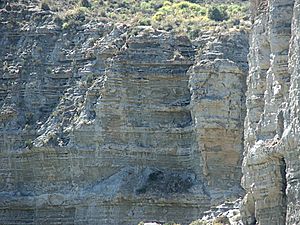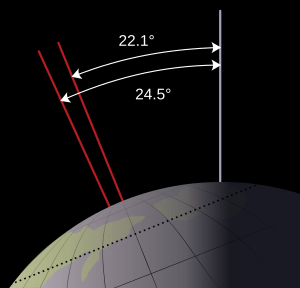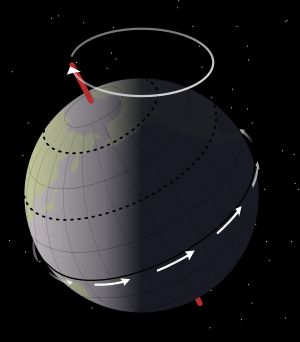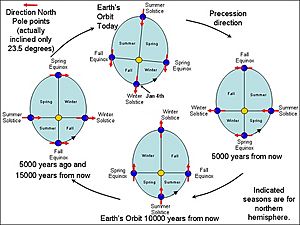Milankovich cycle facts for kids
Milankovich cycles are small, slow, but regular changes in how Earth moves around the Sun. They also describe changes in the tilt of Earth's axis. These changes affect how much sunlight reaches different parts of our planet.
These cycles cause Earth's climate to change over very long periods. These climate cycles happen roughly every 21,000, 41,000, 100,000, and 400,000 years. Scientists are still actively studying these fascinating patterns.
A scientist named Milutin Milanković used math to predict that these changes in Earth's orbit and tilt cause climate patterns. Other scientists had similar ideas in the 1800s. However, it wasn't until 1976, when deep-ocean cores were studied, that strong evidence supported Milanković's predictions.
Contents
Understanding Earth's Orbital Cycles
How Earth's Orbit Changes Shape
Earth's path around the Sun is not a perfect circle. It's an ellipse, which is like a stretched circle or an oval. The "eccentricity" tells us how much this ellipse is stretched.
Over time, the shape of Earth's orbit changes. It goes from being almost circular to slightly more oval. This change in shape affects how close Earth gets to the Sun at different times of the year.
How Earth's Tilt Changes (Obliquity)
Imagine Earth spinning like a top. Its axis, the imaginary line it spins around, is tilted. This tilt changes over many thousands of years. The angle of Earth's tilt changes compared to its path around the Sun.
When the tilt increases, summers in both the Northern and Southern Hemispheres get more direct sunlight. Winters get less. When the tilt decreases, summers get less sunlight, and winters get more. These changes in tilt are slow, about 2.4 degrees. They take about 41,000 years to go from 22.1 degrees to 24.5 degrees and back.
How Earth's Axis Wobbles (Precession)
Earth's axis also wobbles, much like a spinning top that is slowing down. This wobble is called "precession." It happens because of the pull of gravity from the Sun and the Moon on Earth. Earth is not a perfect sphere; it bulges slightly at the equator.
This wobble takes about 26,000 years to complete one full cycle. When the axis points toward the Sun, one part of Earth has bigger differences between summer and winter. The other part has milder seasons. For example, if a hemisphere has summer when Earth is closest to the Sun, it will get a lot of heat. But that same hemisphere will have a colder winter when Earth is farthest away.
How Earth's Orbit Rotates (Apsidal Precession)
Not only does Earth's axis wobble, but its entire oval-shaped orbit also slowly rotates in space. This is called "apsidal precession." This rotation is mainly caused by the gravitational pull from the giant planets, Jupiter and Saturn.
This rotation of the orbit changes the timing of the seasons. It shortens the period of the precession of the equinoxes from about 25,771 years to around 21,636 years. This means that the point in Earth's orbit where spring begins shifts over time.
How Earth's Orbit Tilts (Orbital Inclination)
Earth's orbit also drifts slightly up and down compared to its current path. This movement has a cycle of about 70,000 years. Milanković did not study this particular movement.
Scientists have noticed that Earth's orbit moves relative to the orbits of other planets. The "invariable plane" is like the average plane of all the planets' orbits in our Solar System. Earth's orbit tilts relative to this plane in a cycle of about 100,000 years. This 100,000-year cycle is very similar to the 100,000-year cycle of Earth's orbital shape, and it closely matches the timing of past ice ages.
Some scientists think that a disk of dust and debris in this plane might affect Earth's climate. Earth passes through this plane around January 9 and July 9 each year. At these times, there's an increase in meteors and special clouds called noctilucent clouds.
Recent studies of ice cores from Antarctica have provided more evidence for Milanković's ideas. By looking at the oxygen and nitrogen in tiny air bubbles trapped in the ice, scientists found that climate changes were indeed driven by the amount of sunlight reaching the Northern Hemisphere, just as Milanković suggested.
Other pages
Images for kids
-
420,000 years of ice core data from Vostok, Antarctica research station, with more recent times on the left.
See also
 In Spanish: Variaciones orbitales para niños
In Spanish: Variaciones orbitales para niños







